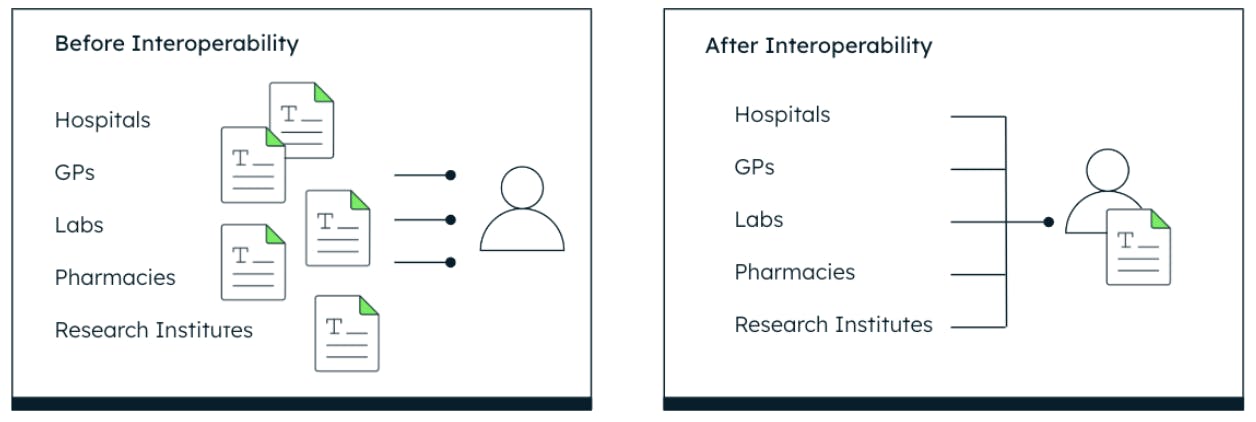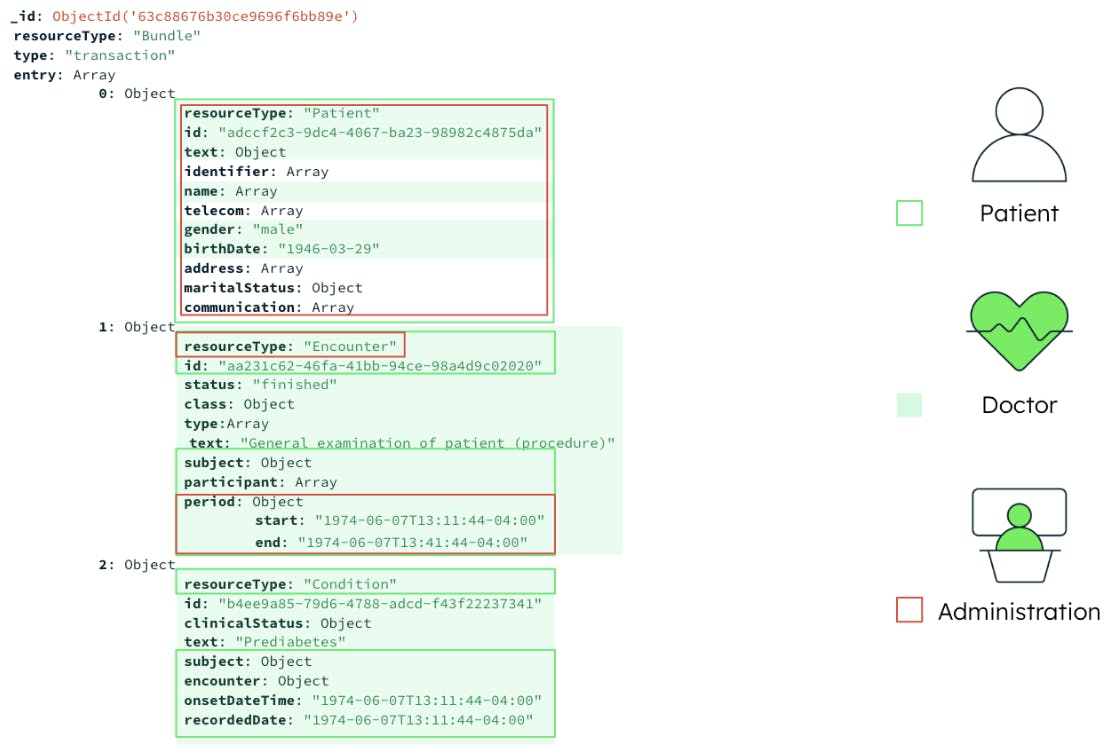4 Ways MongoDB Solves Healthcare's Interoperability Puzzle
May 18, 2023 | Updated: October 6, 2025
Picture this: You're on a road trip, driving across the country, taking in the beautiful scenery, and enjoying the freedom of the open road. But suddenly, the journey comes to a screeching halt as you fall seriously ill and need emergency surgery. The local hospital rushes you into the operating room, but how will they know what medications you're allergic to, or what conditions you've been treated for in the past?

In a perfect world, the hospital staff would have access to all of your medical records, seamlessly integrated into one interoperable electronic health record (EHR) system. This would enable them to quickly and accurately treat you as seen in Figure 1.
Unfortunately, the reality is that data is often siloed, fragmented, and difficult to access, making it nearly impossible for healthcare providers to get a complete picture of their patients' health. That’s where interoperability comes in, enabling seamless integration of data from different sources and formats, allowing healthcare providers with easy access to the information they need, even between different health providers. And at the heart of solving the interoperability challenge is MongoDB, the ideal solution for building a truly interoperable data repository.
In this blog post, we'll explore four ways why MongoDB stands out from all others in the interoperability software space. We'll show you how our unique capabilities make us the fundamental missing piece in the interoperability puzzle for healthcare. Let’s get started!
1. Document flexibility
MongoDB's document data model is perfect for managing healthcare data. It allows you to work with the data in JSON format, eliminating the need to flatten or transform it into a string. This simplifies the implementation of common interoperability standards for clinical and terminology data, such as HL7 FHIR and openEHR, as well as SNOMED and LOINC - because all of these standards also support JSON.
The document model also supports nested and hierarchical data structures, making it easier to represent complex clinical data with varying levels of detail and granularity.
MongoDB's document model also provides flexibility in managing healthcare data, allowing for dynamic and self-describing schemas. With no need to pre-define the schema, fields can vary from document to document and can be modified at any time without requiring disruptive schema migrations. This makes it easy for healthcare providers to add or update information to clinical documents, such as when new interoperability standards are released, ensuring that healthcare data is kept accurate and up-to-date without requiring database reconfiguration or downtime.
2. Scalability
Dealing with large healthcare datasets can be challenging for traditional relational database systems, but MongoDB's horizontal scaling feature offers a solution. With horizontal scaling, healthcare providers can easily distribute their data across multiple servers and cloud providers (AWS, GCP, and Azure), resulting in increased processing power and faster query times.
It also results in more cost-efficient storage as growing vertically is more expensive than growing horizontally. This feature allows healthcare providers to scale their systems seamlessly as their data volumes grow while maintaining performance and reliability. While MongoDB’s reliability is ensured through its replication architecture, where each database replica set consists of three nodes that provide fault tolerance and automatic failover in the event of node failure. Horizontal scaling also improves reliability by adding more servers or nodes to the system, reducing the risk of a single point of failure.
3. Performance
When it comes to healthcare data, query performance can make all the difference in delivering timely and accurate care. And that’s another aspect where MongoDB shines. MongoDB holds data in a format that is optimized for storage and retrieval, allowing it to quickly and efficiently read and write data. MongoDB’s advanced querying capabilities, backed by compound and wildcard indexes, make it a standout solution for healthcare applications. MongoDB Atlas’ Search, using Apache Lucene indexing, also enables efficient querying across vast data sets, handling complex queries with multiple fields. This is especially useful for Clinical Data Repositories (CDRs), which permit almost unlimited querying flexibility. Atlas Search indexing also allows for advanced search features enabling medical professionals to quickly and accurately access the information they need from any device.
4. Security

The security of sensitive clinical data is paramount in the healthcare industry. That’s why MongoDB provides an array of robust security features, including fine-grained access control and auditing as seen in Figure 2. With Client-Side-Field-Level Encryption (CS-FLE) and Queryable Encryption, MongoDB is the only data platform that allows the processing of randomly encrypted patient data, providing the highest level of data security, with minimal impact on performance. Additionally, MongoDB Atlas supports VPC peering and private links that permit secure connections to healthcare applications, wherever they are hosted. By implementing strong security measures from the start, organizations can ensure privacy by design.
Partner ecosystem
MongoDB is the only non-relational database and modern data platform that directly collaborates with clinical data repository (CDR) vendors like Smile, Exafluence, Better, Firely, and others. While some vendors offer MongoDB as an alternative to a relational database, others have built their solutions exclusively on MongoDB, one for example is Kodjin FHIR server. MongoDB has extended its capabilities to integrate with AWS FHIR Works, enabling healthcare providers and payers to deploy a FHIR server with MongoDB Atlas through the AWS Marketplace. With MongoDB's unique approach to data storage and retrieval and its ability to work with CDR vendors, millions of patients worldwide are already benefiting from its use.
Beyond interoperability with MongoDB
Access to complete medical records is often limited by data silos and fragmentation, leaving healthcare providers with an incomplete picture of their patients' health. That's where MongoDB's interoperability solution comes in as the missing puzzle piece the healthcare industry needs. With MongoDB's unmatched document flexibility, scalability, performance, and security features, healthcare providers can access accurate and up-to-date patient information in real-time.
But MongoDB's solution goes beyond that. Radical interoperability with MongoDB means that healthcare providers own the data layer and are thus able to leverage any usages from the stored data, and connect to any existing applications or APIs. They're free to work with any healthcare data standard, including custom schemas, and leverage the data for use cases beyond storage and interoperability.
The future of healthcare is here, and with MongoDB leading the way, we can expect to see more innovative solutions that put patients first. If you're interested in learning more about radical interoperability with MongoDB, check out our brochure.